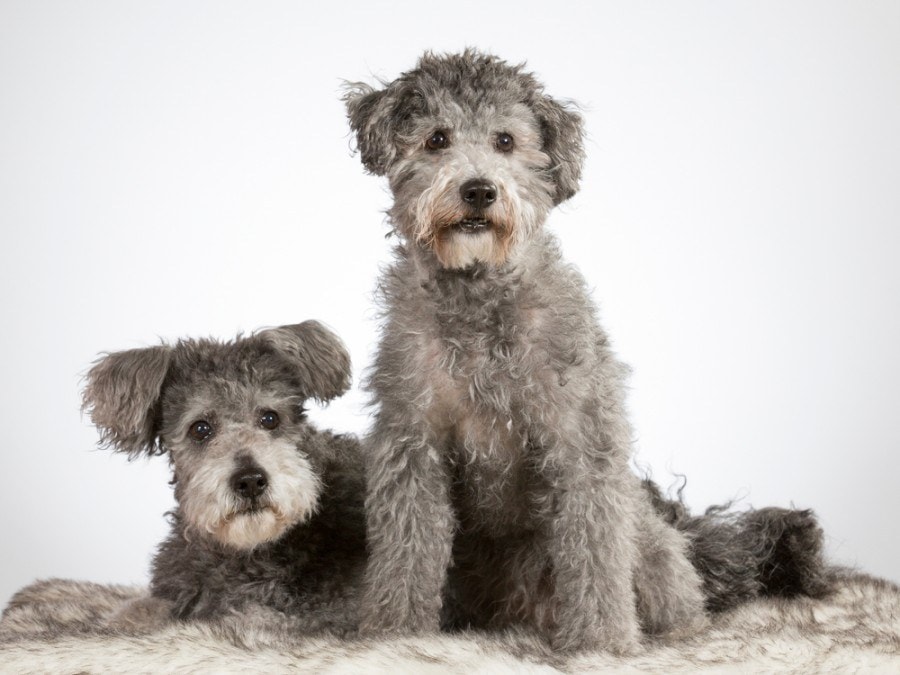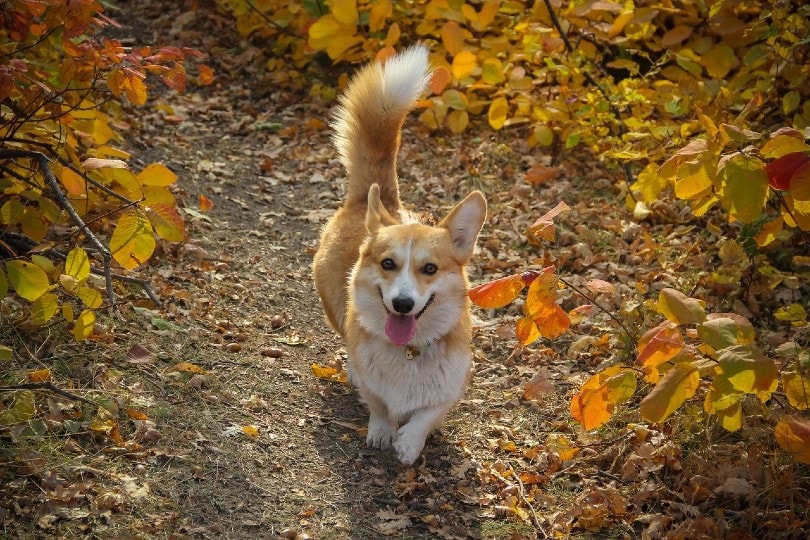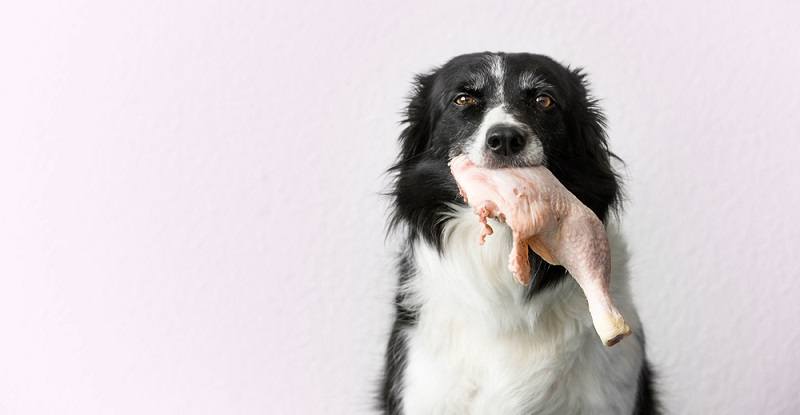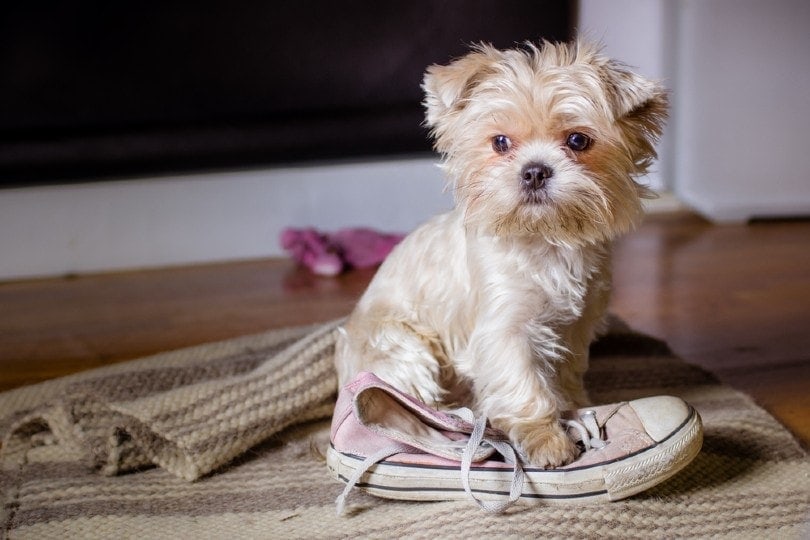Height:
15 – 18.5 inches
Weight:
22 – 29 pounds
Lifespan:
12 – 13 years
Colors:
Black, Gray, Silver Gray, White, Fawn
Suitable for:
Active families, House with a Yard
Temperament:
Energetic, Intelligent, Confident, Lively, Agile
The Pumi (pronounced POO-me) is an AKC recognized purebred from the Herding Group and is a lively, intelligent dog bred to herd sheep and cattle in Hungary. They become attached to their family quickly and are affectionate and energetic dogs that are protective of everyone in the household.
Pumis are medium-sized dogs with curled tails and erect ears that flop over at the ends, giving them a rather whimsical appearance. They come in a variety of colors such as black, white, silver-gray, gray, and fawn and can have black & tan or brindle markings. They are most well known for their gorgeous corkscrew curly coats of fur.
Pumi Puppies – Before You Buy…
Pumis are high energy dogs that are very healthy and are known to live past their expected lifespan. They are easy to train due to their intelligence and willingness to please, but they can be wary of strangers.
What’s the Price of Pumi Puppies?
Pumis are a rare purebred dog in North America, so be prepared to wait quite some time if you choose to either adopt one from a rescue group or purchase a puppy from a breeder. Expect to pay around $300 to $600 for adopting a rescue dog or $1000 to $2500 from a breeder.
You’ll want to avoid buying a puppy from a puppy mill, so finding a reputable and responsible breeder is paramount.
- Meet the breeder: Your best bet is to meet the breeder at their location so you can see the condition of their kennels and their dogs. You’ll want to observe the relationship between the breeder and their dogs; are the dogs happy and in good health, and do they have a loving relationship with the breeder? You should consider using video chat if you are unable to meet at the breeder’s location.
- Ask loads of questions: You must come prepared with questionsfor the breeder, and they should be happy to answer them. Don’t worry about asking too many questions or if any of your questions seem “dumb.” There’s no such thing as a dumb question if it’s relevant to you.
- Meeting the puppy’s parents: Not only will meeting your puppy’s parents ensure they’re in good health and well cared for, but it will also give you an idea about your puppy’s appearance and behavior when it becomes an adult.
- Ask for the medical background: A reputable breeder will provide you with their puppy’s and dog’s medical background and be happy to discuss any concerns you might have.
There will be additional costs for raising a puppy and taking care of an adult dog that needs to be considered.
- Food
- Water and food bowls
- Treats
- Leash, harness, and collar
- Play and chew toys
- Puppy training pads
- Crate and bedding
- Visits to the vet
- Neutering or spaying surgery
- Microchipping
- Grooming
- Training/obedience classes
You should also consider adopting a dog, as mentioned previously. Adoption fees are less than purchasing a puppy from a breeder, and most rescue groups waive the adoption fee if you adopt a senior or special needs dog. There are also breed-specific rescue groups like the Pumi Rescue run out of the Hungarian Pumi Club of America.
3 Little-Known Facts About the Pumi
1. The Pumi likes high places.
They love to know what’s going on at all times and will, at times, gravitate to high places to check everything out.
2. The Pumi is one of three Hungarian herding dogs.
The Mudi, which is in the Miscellaneous Class, and the Puli, are all Hungarian herding dogs but the Pumi comes in as a little more popular than the Puli with a rank of 151 compared to the Puli’s 160 out of 196.
- Related Read: 15 New Dog Breeds: Updated in 2020
3. The Pumi is a barker.
Because the Pumi is a herding dog, they tend to be quite vocal and might not be the best dog for apartment living.

Temperament & Intelligence of the Pumi
The Pumi is an energetic breed that is a quick learner and excels at working as it is agile and is willing to work endlessly. They will bond with the entire family but will choose one person out of the family as their favorite.
Pumis are herding dogs and will attempt to herd children and smaller animals in the household. They are very intelligent and lively dogs. Their intelligence allows them to evaluate every new situation, whether its new places or strangers, and they might appear standoffish while figuring out their circumstances.
Are These Dogs Good for Families?
Pumis are excellent family dogs as they enjoy spending time and bonding with the entire family. They will protect the whole family but without any serious aggression, and they are devoted and affectionate. Because they are herding dogs, they might tend to nip at the heels and legs of younger children in an attempt to herd them, but they won’t hurt them.
Does This Breed Get Along with Other Pets?
The Pumi will get along with all other pets in the household, provided they are socialized as puppies and were raised with them. Just like with the children, the Pumi might also attempt to herd other animals, and they should be watched around any pets other than cats and dogs.
Things to Know When Owning a Pumi:
Food & Diet Requirements
Pumis are medium-sized dogs and should be fed high-quality dog food, which should work out to about 1 to 1½ cups of kibble 2 times a day. How often and how much you feed them can be determined by following the instructions on the back of the food bag and consulting with your vet.
Be careful with giving your Pumi treats and human food as you want your dog to avoid overeating or eating something that could cause harm. Speak to your vet if you’re ever concerned about your Pumis health and weight.
Exercise
Pumis are highly energetic and will need lots of daily exercise as well as activities to help with mental stimulation. They enjoy chasing and fetching, so throwing balls and frisbees is an excellent way to help them burn off some of their energy. They also excel at various dog sports such as agility, obedience, tracking, and naturally, herding. If the Pumi is left alone for too long and isn’t given enough exercise and playtime, they will become noisy and destructive.
Training
The Pumi learns quickly as it is a smart dog and will pick up training quite easily. They should be socialized early, and as with most dogs, the Pumi will respond best to positive reinforcement. As long as it has enough mental stimulation and exercise, it will grow up a well-adjusted and happy dog.
Grooming ✂️
The grooming process for the Pumi is low maintenance but with a few notes. Their curly coat is unique with half of the fur being coarse and the other half soft. It is recommended to comb your Pumi every 3 to 6 weeks but combing them once a week will help remove dirt and mats. After combing your Pumi, you should wet down its coat (no shampoo) and allow it to airdry, all of which will bring the curls back up. Avoid using a blow dryer, or you’ll end up with a frizzy, poufy dog.
The Pumi should be given a bath not more than once a month with a high-quality dog shampoo. Any more frequently than that could damage your dog’s skin. The Pumi does need to be trimmed occasionally, about once every 2 or 3 months.

You also need to brush their teeth several times a week, clean their ears about once a month and trim their nails around every 3 or 4 weeks.
Health and Conditions
The vet will check the Pumis hips, elbows, and knees and run an MRI and CT scans to check their spine for any issues. Your vet with run a full physical exam on your Pumi and check its eyes for any potential problems.
- Dislocated eye lens
- Hip dysplasia
- Elbow dysplasia
- Kneecap dislocation
- Spinal cord disease

Male vs. Female
The female Pumi is a little smaller and lighter than the male. She might run 15 to 17 inches in height compared to the male at 16 to 18 inches. The female might weigh about 22 to 24 pounds and the male around 27 to 29 pounds.
If you elect to have surgery for your dog, neutering the male dog is not as complicated as spaying the female and is, therefore, less expensive and has a shorter recovery time. Neutering and spaying can potentially give your dog a longer lifespan as it might prevent future health issues. Your dog also might be less likely to run away and could lose any aggressive behavior.
Finally, some believe that there’s a difference in temperament between males and females. It’s thought that the females are generally less aggressive and more affectionate than the males, but there are discussions about this perspective. However, how a dog was socialized and trained and how it’s been treated throughout its life will be the main determinate of its personality and behavior.
- Think this dog is adorable? Learn about other dogs that start with the letter P
Final Thoughts
The Pumi looks like an adorable muppet with its perky ears and fluffy, curly coat and is a smart and lovely companion.
As previously mentioned, the Pumi is a rather rare purebred, particularly in North America. If you’re looking for a Pumi puppy, you could start by looking for breeders of the Pumi, but if there aren’t any in your area, you could attend dog shows or speak to local and national dog clubs. Some breeders are willing to fly puppies to your location but be prepared for a much larger expense. Posting a message on social media will also spread your message to a bigger audience. Also, don’t forget to look into adopting a rescue dog.
If you want to add a lively, affectionate, and smart dog to your family, the Pumi is a unique and loving bundle of floof that will make a wonderful addition to the right family.
Featured Image Credit: Katinka Bakos, Shutterstock










